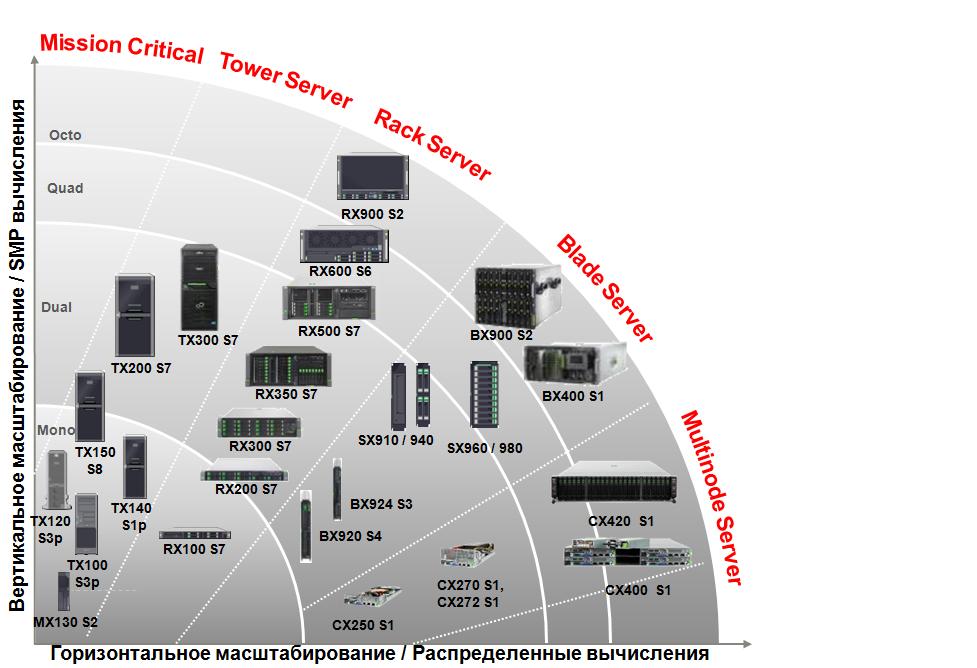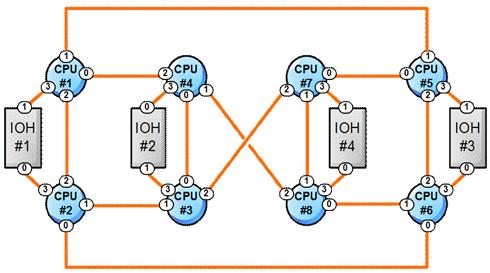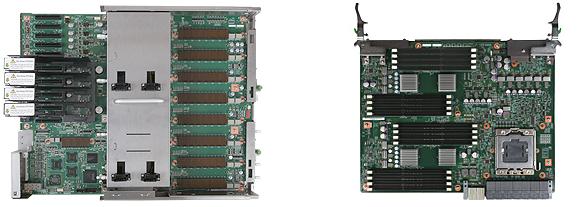PRIMERGY RX900 S2: Fujitsu monolithic 8-processor server
There are two ways to increase computing power: an increase in the number of processors in each computing node (vertical scaling) and an increase in the number of computing nodes (horizontal scaling). Currently, the first path is implemented by SMP-systems (UMA and NUMA), in the second - by distributed computing. Regardless of which path is preferred, Fujitsu is ready to provide its solutions for any of them:

At the very top of the diagram, there is the flagship of the Fujitsu PRIMERGY server family - the RX900 S2 server, a distinctive feature of which is the presence of eight processor sockets. This server will be discussed today.
')
The PRIMERGY RX900 S2 server is a modern 8U rack server with 8 processor sockets for Intel Xeon processors of the E7-8800 family, which includes models with 8 and 10 cores. Thus, the RX900 can have up to 80 processor cores, and at the expense of Intel Hyper-Threading technology, it can handle 160 threads simultaneously. Such an impressive number of cores requires an appropriate amount of RAM, the maximum size of which in this server can reach 4 TB. This volume is achieved by installing 128 DDR3 DIMM modules with ECC support of 32 GB each.
To improve reliability and fault tolerance, memory mirroring can be used, and the RAS built-in functions in the processor can effectively bypass errors, eliminating the appearance of a blue screen of death (BSOD).

The disk subsystem of the server in question includes up to 8 hard drives or SAS 2.0 (2.5 ") SSDs with an interface speed of 6 Gb / s with a total volume of up to 8 TB, which can be organized in RAID levels 0/1/5/6/10 / 50/60 using a hardware RAID controller.In addition, the RX900 supports up to 4 SSDs with a PCI-Express 2.0 x4 interface with a total capacity of up to 4.8 TB. If this volume is not enough, then use Fujitsu ETERNUS Direct Attach Storage (DAS) JX40 , which will take an additional 2U in the rack, you can add another 24 2.5 ”drives.

The PRIMERGY RX900 S2 I / O subsystem contains 6 Gigabit Ethernet ports and up to two 10 Gbps Ethernet ports with SFP + connectors, allowing you to install both SFP + optical modules and direct connection cables of up to 10 m. , you can install additional Fiber Channel, Infiniband or Ethernet adapters and others, using the available 16 PCI-Express 2.0 slots: 2 x4 slots (using the x8 physical slot), the rest x8.
The RX900 power supply system includes up to 4 power units with a power of 2000 W each, capable of providing 2 + 1 and 2 + 2 redundancy with the possibility of using independent power sources to increase server resiliency. To increase the latest and reduce the server shutdown time while performing work on the replacement of certain components, hot replacement technologies are widely used in the server: so without shutting down the server, you can replace power supplies, hard drives, cooling fans and some PCI-Express devices.
Fujitsu PRIMERGY RX900 S2 server is built on the Intel QuickPath Interconnect architecture (QPI), which implies the presence of a memory controller in the processor and the use of high-speed QPI bus to connect the processors to each other and to input / output concentrators (IOH). In this case, the memory uses the NUMA architecture: its own memory for each of the processors is local, and the memory connected to other processors is remote. Another feature of this architecture is the scaling of I / O bandwidth depending on the number of I / O hubs.
Each of the Intel Xeon processors of the E7-8800 family has 4 QPI buses, while each IOH is 2. The connection diagram of the processors (CPU) and hubs (IOH) is shown in the figure below:

Taking into account the peculiarities of the QPI architecture, the PRIMERGY RX900 S2 processors are connected to the motherboard not directly, but through a special riser (CPUMemory Board - CPUMEMR), on which its local RAM is also located. In addition, each of the processors is placed on a separate CPUMEMR with one processor socket and 16 RAM sockets. Such a performance allowed to increase the density of components in the server. In the photos below: on the left - the motherboard, on the right - CPUMEMR.

Fujitsu PRIMERGY RX900 S2 servers initially incorporated extensive linear scaling capabilities that, thanks to the Intel QPI architecture, are implemented inside the server chassis without requiring additional hardware, which could lead to changes in the existing data center infrastructure.
In the basic configuration, the RX900 has 4 processor sockets and 64 RAM sockets (4 CPUMEMR). Further expansion is performed by adding additional processor raisers, while configurations with 6 and 8 processors are supported. In addition, the addition of every two CPUMemory Boards activates an additional I / O hub, ensuring the inclusion of the corresponding PCI-Express slots. In this way, a simultaneous increase in I / O performance, memory and processing power is ensured.
Depending on the number of CPUMEMR, the PRIMERGY RX900 S2 server will have the following number of corresponding slots:

Servers with 8 processor slots are usually perceived as very expensive and niche devices. This opinion is quite reasonable, because the cost of such decisions often exceeds the mark of $ 100,000. The high cost imposes the corresponding responsibility when making decisions related to the acquisition of such servers, thereby increasing the demand specifically for branded turnkey solutions, the performance and compatibility of components of which are guaranteed by the manufacturer.
This is exactly the solution of the second generation of Fujitsu PRIMERGY RX900 servers, which, at a reasonable price, provides much more serious levels of reliability and fault tolerance. In this case, RX900 is designed specifically for mission-critical applications, corporate databases and large-scale consolidation of virtual machines, taking into account the requirements imposed by the relevant tasks. It is the monolithic design of the PRIMERGY RX900 that makes it possible to fully utilize the functionality of hot-swappable components, unlike solutions made up of two 4-processor systems, the design of which requires stopping the entire system to access certain internal components or power supplies to replace them.
It is also important that Fujitsu provides a three-year warranty on the server with the maintenance at the customer’s site. Additionally, you can purchase various support options, including round-the-clock service, with on-site service for four hours. Thus, the availability of various technologies for protection against failures, together with high-quality service, significantly reduce the downtime of expensive equipment.

At the very top of the diagram, there is the flagship of the Fujitsu PRIMERGY server family - the RX900 S2 server, a distinctive feature of which is the presence of eight processor sockets. This server will be discussed today.
')
Specifications
The PRIMERGY RX900 S2 server is a modern 8U rack server with 8 processor sockets for Intel Xeon processors of the E7-8800 family, which includes models with 8 and 10 cores. Thus, the RX900 can have up to 80 processor cores, and at the expense of Intel Hyper-Threading technology, it can handle 160 threads simultaneously. Such an impressive number of cores requires an appropriate amount of RAM, the maximum size of which in this server can reach 4 TB. This volume is achieved by installing 128 DDR3 DIMM modules with ECC support of 32 GB each.
To improve reliability and fault tolerance, memory mirroring can be used, and the RAS built-in functions in the processor can effectively bypass errors, eliminating the appearance of a blue screen of death (BSOD).

The disk subsystem of the server in question includes up to 8 hard drives or SAS 2.0 (2.5 ") SSDs with an interface speed of 6 Gb / s with a total volume of up to 8 TB, which can be organized in RAID levels 0/1/5/6/10 / 50/60 using a hardware RAID controller.In addition, the RX900 supports up to 4 SSDs with a PCI-Express 2.0 x4 interface with a total capacity of up to 4.8 TB. If this volume is not enough, then use Fujitsu ETERNUS Direct Attach Storage (DAS) JX40 , which will take an additional 2U in the rack, you can add another 24 2.5 ”drives.

The PRIMERGY RX900 S2 I / O subsystem contains 6 Gigabit Ethernet ports and up to two 10 Gbps Ethernet ports with SFP + connectors, allowing you to install both SFP + optical modules and direct connection cables of up to 10 m. , you can install additional Fiber Channel, Infiniband or Ethernet adapters and others, using the available 16 PCI-Express 2.0 slots: 2 x4 slots (using the x8 physical slot), the rest x8.
The RX900 power supply system includes up to 4 power units with a power of 2000 W each, capable of providing 2 + 1 and 2 + 2 redundancy with the possibility of using independent power sources to increase server resiliency. To increase the latest and reduce the server shutdown time while performing work on the replacement of certain components, hot replacement technologies are widely used in the server: so without shutting down the server, you can replace power supplies, hard drives, cooling fans and some PCI-Express devices.
Architecture features
Fujitsu PRIMERGY RX900 S2 server is built on the Intel QuickPath Interconnect architecture (QPI), which implies the presence of a memory controller in the processor and the use of high-speed QPI bus to connect the processors to each other and to input / output concentrators (IOH). In this case, the memory uses the NUMA architecture: its own memory for each of the processors is local, and the memory connected to other processors is remote. Another feature of this architecture is the scaling of I / O bandwidth depending on the number of I / O hubs.
Each of the Intel Xeon processors of the E7-8800 family has 4 QPI buses, while each IOH is 2. The connection diagram of the processors (CPU) and hubs (IOH) is shown in the figure below:

Taking into account the peculiarities of the QPI architecture, the PRIMERGY RX900 S2 processors are connected to the motherboard not directly, but through a special riser (CPUMemory Board - CPUMEMR), on which its local RAM is also located. In addition, each of the processors is placed on a separate CPUMEMR with one processor socket and 16 RAM sockets. Such a performance allowed to increase the density of components in the server. In the photos below: on the left - the motherboard, on the right - CPUMEMR.

Scaling
Fujitsu PRIMERGY RX900 S2 servers initially incorporated extensive linear scaling capabilities that, thanks to the Intel QPI architecture, are implemented inside the server chassis without requiring additional hardware, which could lead to changes in the existing data center infrastructure.
In the basic configuration, the RX900 has 4 processor sockets and 64 RAM sockets (4 CPUMEMR). Further expansion is performed by adding additional processor raisers, while configurations with 6 and 8 processors are supported. In addition, the addition of every two CPUMemory Boards activates an additional I / O hub, ensuring the inclusion of the corresponding PCI-Express slots. In this way, a simultaneous increase in I / O performance, memory and processing power is ensured.
Depending on the number of CPUMEMR, the PRIMERGY RX900 S2 server will have the following number of corresponding slots:

Application features and benefits
Servers with 8 processor slots are usually perceived as very expensive and niche devices. This opinion is quite reasonable, because the cost of such decisions often exceeds the mark of $ 100,000. The high cost imposes the corresponding responsibility when making decisions related to the acquisition of such servers, thereby increasing the demand specifically for branded turnkey solutions, the performance and compatibility of components of which are guaranteed by the manufacturer.
This is exactly the solution of the second generation of Fujitsu PRIMERGY RX900 servers, which, at a reasonable price, provides much more serious levels of reliability and fault tolerance. In this case, RX900 is designed specifically for mission-critical applications, corporate databases and large-scale consolidation of virtual machines, taking into account the requirements imposed by the relevant tasks. It is the monolithic design of the PRIMERGY RX900 that makes it possible to fully utilize the functionality of hot-swappable components, unlike solutions made up of two 4-processor systems, the design of which requires stopping the entire system to access certain internal components or power supplies to replace them.
It is also important that Fujitsu provides a three-year warranty on the server with the maintenance at the customer’s site. Additionally, you can purchase various support options, including round-the-clock service, with on-site service for four hours. Thus, the availability of various technologies for protection against failures, together with high-quality service, significantly reduce the downtime of expensive equipment.
Source: https://habr.com/ru/post/190666/
All Articles